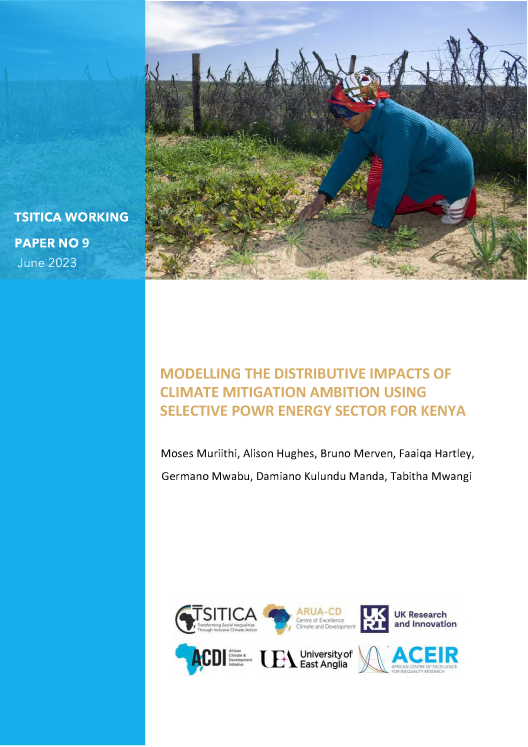Modelling the distributive impacts of climate mitigation ambition using selective power energy sector for Kenya
Moses Muriithi, Alison Hughes, Bruno Merven, Faaiqa Hartley, Germano Mwabu, Damiano K. Manda, and Tabitha Mwangi
TSITICA Project Working Paper no. 9, June 2023.
Published by ARUA Centre of Excellence in Climate Change and Development & African Centre of Excellence for Inequality Research.

Inequality and poverty dimensions in Kenya are affected by climate change policies that target reducing carbon emissions as spelt in Nationally Determined Contribution (NDC) climate action of 2018 for Kenya. This paper aims at testing the impact of such mitigation policy that focuses on energy sector. It seeks to assess the impact of a clean energy policy on poverty and inequality in the context of climate change in Kenya. The study uses Kenya CGE model based on the national 2019 social accounting matrix (SAM), developed by the International Food Policy Research Institute to inform the underlying structure of the economy in the base year. Other data include power generation and consumption data, and energy statistics for Kenya. Simulations in the model include no-emission constrained and emission constrained scenarios of; forced inclusion of a 3.6Mton LNG terminal in 2028 and a floating Storage regassification unit from 2026.
The results indicate that, in scenario without mitigation, households fare better under the flexible gas scenario than the big gas scenario. Poverty rates are lower in both rural and urban areas, although reductions in urban areas are larger. Incomes are higher in both rural and urban areas in the flexible gas scenario with lower income quintiles experiencing larger increases than households in higher income quintiles. Income increases are also larger in rural areas. With mitigation, relative to the NDC_BigGas scenario, poverty levels are lower, but inequalities increase with in NDC_FlexGas scenario. Real GDP is higher in the NDC_FlexGas scenario than the NDC_BigGas scenario. Further, employment, in line with GDP, is higher in NDC_FlexGas compared to the NDC_BigGas scenarios. Further gains in income sources such as land and enterprise return results lead to higher household incomes and real consumption expenditure. Another key finding is that the cost of power generation will benefit more from global climate financing whose least cost scenario will be diffused to increased sectoral growth hence enhancing poverty reduction in Kenya. Read more
TSITICA was a collaborative, multi-country interdisciplinary research project. It brought together two ARUA Centres of Excellence with researchers from the universities of Ghana, Nairobi and Cape Town, and from the UK universities of Bristol, East Anglia and Manchester and the London School of Economics. The support of the African Research Universities Alliance and UK Research and Innovation are gratefully acknowledged. Visit project website.
